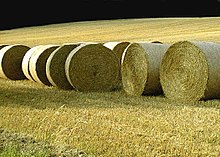Stalk-like biomass
Under herbaceous biomass , or in the case of pure energy use as herbaceous fuel referred, in particular, organic revenue from one to several years of non-wood plants referred to in are agriculture are by-products and crop residues as well as in the countryside. This particularly includes straw and grass that are used for energy purposes.
definition
There is no clear definition of stalk-like biomass. As a rule, this term includes all those fractions that have a clear stalk-like character, i.e. above all straw fractions and grasses . In the Anglo-Saxon-speaking area in particular, however, this is often extended to all biomass components that do not belong to the category of wood, which means that olive pits, nutshells and vegetable pods also fall into this definition. If one compares this characterization with the European fuel classification according to EN 14961, it essentially corresponds to group 2 classified as “stalk and herbaceous fuels”, while other biomass fractions refer to “woody biomass”, “biomass of fruits” and “defined and undefined mixtures ”are to be divided.
composition
The stalk-like biomass is primarily composed of crop residues from the harvest of grain , oilseeds , legumes and grain maize . A large proportion of these residues are worked back into the soil as a humus-forming substrate after the harvest.
The largest volume is made up of cereal straw , which comes from the cultivation and use of various types of grain (especially wheat , barley , rye and triticale ). In Europe, for example, grain is grown on around 70% of the arable land, in Germany it is around 57%. However, far less than half of the theoretically usable grain straw is available for further uses, while the majority remains in the field and is plowed under. The grain is followed by oilseeds with around 16% of the cultivated area, especially rapeseed. On average, a production of around 3.5 t rapeseed produces around 10 t of rapeseed straw . When using sunflowers , around 10 t per 2.5 t of oilseed are produced during harvest. Corn stover when growing grain maize (not with energy maize , where the entire plant is used) falls in a ratio of 1: 1.3 a, an average of 6.8 t of corn kernels per hectare and year, so 9 t of corn stalks. Legume straw is produced in relatively small quantities, in Germany mainly from the cultivation of the field bean . In addition to this amount of straw, in agriculture there are also crop residues from the cultivation of potatoes , vegetables and hops in sometimes very large quantities. However, there are hardly any usable amounts from these fractions, most of the residues remain in the field as humus-forming biomass.
Apart from agriculture, stalk-like biomass occurs primarily in the field of landscape maintenance in the form of street grass cuttings from the maintenance of roadsides and railway lines, grass cuttings from parks, plants and cemeteries and from mowing in nature conservation areas . On the other hand, biomass accruing privately through lawn cutting does not play a significant role.
use
Stalk-like biomass is used both energetically and materially. A number of material applications take place directly in agriculture. This includes, in particular, the use of cereal straw as animal bedding , whereby it is used for fertilization in the form of manure after use , or the cover for plantings (especially strawberry plantations). As a possibility for the future, cereal straw for biotechnological use in the biorefinery is of particular interest; the green biorefinery is expressly based on the use of fresh biomass such as grasses.
The energetic use takes place both as a biogas substrate (especially for green waste ) and by burning the dry straw material in appropriate combustion systems (straw burning). So the energetic use of cereal straw in heating and power plants occurs only in some European countries, especially in Denmark, Spain and Great Britain; in total, only about 1% of the total volume is used in this way. Work on the construction site for Germany's first straw power plant with a combustion output of 50 MW is to begin in October 2010 in Emlichheim in Emsland.
Problems with incineration are usually very high ash contents with, at the same time, very low ash softening temperatures and therefore heavy slagging of the furnace as well as the costly preparation and drying of the biomass.
supporting documents
- ↑ a b c d Stalk-like biomass. In: Martin Kaltschmitt, Hans Hartmann, Hermann Hofbauer (Hrsg.): Energy from biomass. Basics, techniques and procedures. Springer Verlag, Berlin and Heidelberg 2009; Pp. 148-157. ISBN 978-3-540-85094-6 .
- ↑ CEN / TS 14961: 2005: Solid Biofuels - Fuel Specifications and Classes. German version 2005.
- ↑ - Planned straw power plant in Germany ( Memento of the original from February 29, 2016 in the Internet Archive ) Info: The archive link was automatically inserted and not yet checked. Please check the original and archive link according to the instructions and then remove this notice.
literature
- Stalk-like biomass. In: Martin Kaltschmitt , Hans Hartmann, Hermann Hofbauer (Hrsg.): Energy from biomass. Basics, techniques and procedures. Springer Verlag, Berlin and Heidelberg 2009; Pp. 148-157. ISBN 978-3-540-85094-6 .
